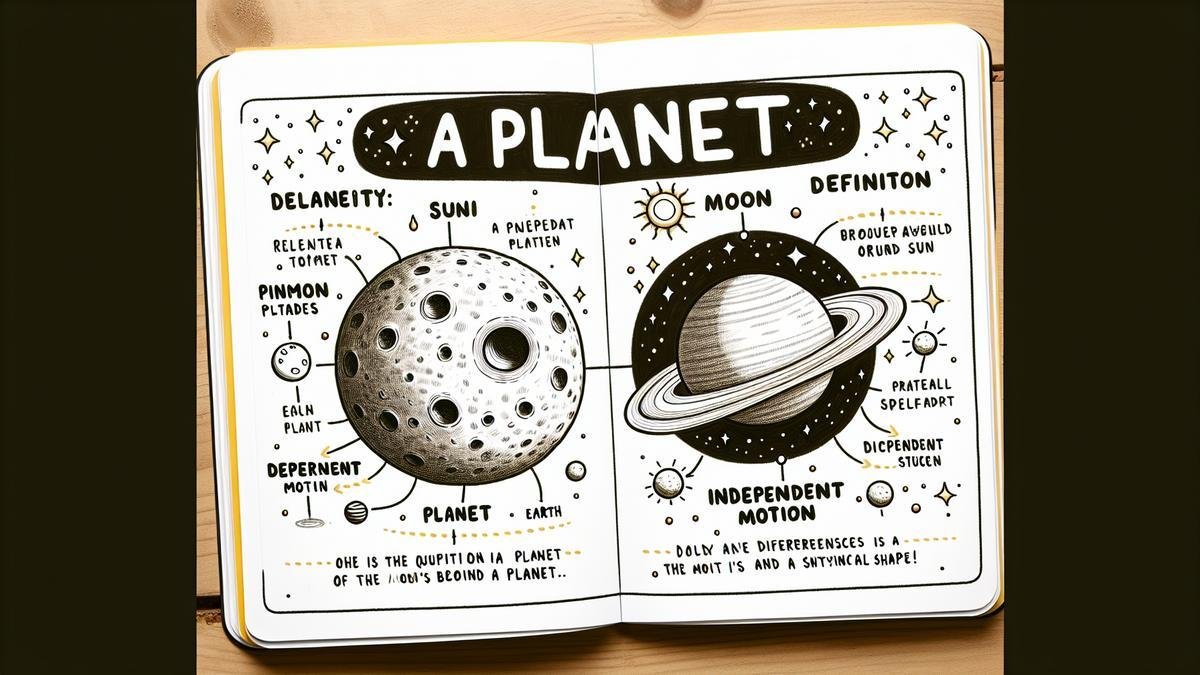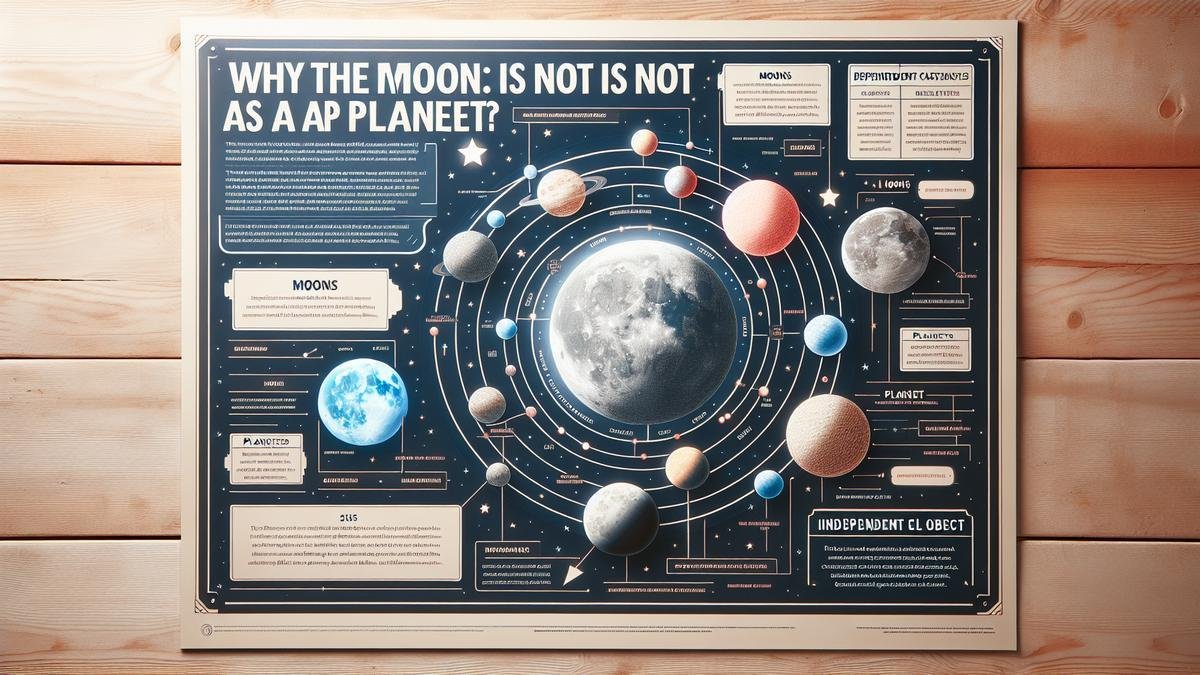Is the moon a planet? Youve probably wondered this at some point. Its a common question with a fascinating answer. In this article, well dive into what truly defines a planet, the differences between planets and moons, and why the moon, despite its unique features and significant history, doesnt make the cut. Well also explore the moons influence on Earth, scientific discoveries over time, and future missions. So, get ready to uncover the mysteries and importance of our moon! 🌕
Key Points
- The Moon is not a planet.
- Its Earth’s only natural satellite.
- It orbits around Earth.
- It’s different from planets in the solar system.
- The Moon impacts tides on Earth.

What Defines a Planet?
So, you’re probably wondering, is the Moon a planet? It’s a question that’s puzzled many. Let’s dive in and see what sets a planet apart from other celestial bodies.
Characteristics of a Planet
When it comes to defining a planet, astronomers have a few boxes to check. Here are the main characteristics:
- Orbits a star: Planets revolve around a star, like how Earth orbits the Sun.
- Sufficient mass: A planet needs enough mass to have a nearly round shape, a result of its own gravity.
- Cleared its orbit: This means the planet has enough gravitational pull to clear away other objects in its path.
Here’s a quick table to break it down:
| Characteristic | Description |
|---|---|
| Orbits a Star | Must revolve around a star, e.g., the Sun. |
| Sufficient Mass | Needs enough mass to be nearly spherical. |
| Cleared its Orbit | Must have cleared its orbital path of other debris. |
Differences Between Planets and Moons
Now, let’s talk about how planets and moons differ. While both are celestial bodies, they have distinct characteristics.
- Orbit: Moons orbit planets, not stars.
- Size: Generally, moons are smaller than planets.
- Formation: Moons can form from debris left over from a planet’s formation or be captured by a planet’s gravity.
Here’s a handy table to summarize:
| Feature | Planets | Moons |
|---|---|---|
| Orbit | Around a star | Around a planet |
| Size | Usually larger | Usually smaller |
| Formation | Formed from protoplanetary disks | Formed from debris or captured |
Why the Moon Doesn’t Qualify
So, why isn’t the Moon considered a planet? Let’s break it down:
- Orbit: The Moon orbits Earth, not the Sun.
- Size: While the Moon is large compared to other moons, it’s still smaller than most planets.
- Cleared its orbit: The Moon hasn’t cleared its orbit of other debris; it’s actually part of Earth’s gravitational influence.
In essence, the Moon doesn’t meet the criteria to be classified as a planet. It’s more of a sidekick to Earth, not a standalone hero in the cosmic story.
The Moon’s Unique Features
Size and Composition of the Moon
The Moon is a fascinating celestial body. It’s smaller compared to Earth, with a diameter of about 3,474 kilometers. That’s roughly one-quarter the size of our planet. The Moon’s surface is a mix of rocky terrain and dust, known as regolith. This surface is peppered with craters from countless impacts over billions of years.
Here’s a quick overview of the Moon’s size and composition:
| Feature | Measurement/Description |
|---|---|
| Diameter | 3,474 kilometers |
| Surface Area | 37.9 million square kilometers |
| Composition | Rocky terrain, dust (regolith) |
| Gravity | 1/6th of Earth’s gravity |
The Moon’s Orbit Around Earth
The Moon orbits Earth in a synchronized dance. It takes about 27.3 days to complete one orbit. This period is known as a sidereal month. The Moon’s orbit is not a perfect circle; it’s an ellipse. This causes the distance between the Earth and the Moon to vary. On average, the Moon is about 384,400 kilometers away from Earth.
Key details about the Moon’s orbit:
| Aspect | Description |
|---|---|
| Orbital Period | 27.3 days (sidereal month) |
| Distance from Earth | 384,400 kilometers (average) |
| Orbital Shape | Elliptical |
| Phases | New Moon, First Quarter, Full Moon, Last Quarter |
How the Moon Influences Earth
The Moon’s gravitational pull has a significant impact on Earth. It affects the tides, causing the water levels in oceans to rise and fall. This phenomenon, known as tidal forces, is crucial for marine life and coastal ecosystems. The Moon also stabilizes Earth’s axial tilt, which helps maintain a consistent climate.
Influences of the Moon on Earth:
- Tides: The gravitational pull causes high and low tides.
- Axial Tilt: Stabilizes Earth’s tilt, aiding in climate consistency.
- Night Light: Reflects sunlight, providing light during the night.

Historical Perspectives on the Moon
Ancient Beliefs About the Moon
You know, the moon has always been a source of fascination. In ancient times, people had some pretty wild ideas about it. They saw the moon as a goddess, a god, or even a magical entity.
- Greeks: The Greeks worshipped the moon goddess Selene. They believed she drove a chariot across the night sky.
- Romans: The Romans had their own moon goddess, Luna, who was also thought to ride a chariot.
- Chinese: In Chinese mythology, the moon was home to the Jade Rabbit, who made elixirs of immortality.
These stories show just how much people loved to imagine what the moon could be. They didn’t have telescopes or satellites, so they used their imagination to fill in the blanks.
Scientific Discoveries Over Time
As time went on, our understanding of the moon changed a lot. Thanks to science, we have a much better idea of what the moon really is.
Changing Views in Astronomy
- Galileo: In the 1600s, Galileo used a telescope to look at the moon. He saw that it had craters and mountains. This was a big deal because it showed the moon wasn’t a smooth, perfect sphere.
- Isaac Newton: Newton’s laws of motion and gravity helped explain how the moon orbits the Earth. This was a game-changer for astronomy.
- Apollo Missions: In the 1960s and 1970s, NASA’s Apollo missions brought back moon rocks and gave us more info than ever before.
| Scientist | Contribution |
|---|---|
| Galileo | Discovered craters and mountains on the moon |
| Newton | Explained moon’s orbit with laws of motion and gravity |
| NASA | Brought back moon rocks and detailed data |
Is the Moon a Planet?
Now, let’s get to the big question: Is the moon a planet? To answer this, we need to look at what makes a planet a planet.
- Orbits a Star: Planets orbit stars. The moon orbits Earth, not the Sun.
- Clears Its Orbit: Planets clear their orbit of other objects. The moon shares its orbit with Earth.
- Spherical Shape: The moon is round, just like planets.
So, while the moon has some planet-like qualities, it doesn’t meet all the criteria. It’s actually a natural satellite.
You might wonder, “Why does it matter?” Well, understanding these definitions helps us better grasp our place in the universe. Plus, it’s just plain interesting!
The Importance of the Moon
Tides and Ocean Movements
You might not think about it often, but the Moon has a profound impact on our daily lives. One of the most noticeable effects is on the tides and ocean movements. The gravitational pull of the Moon is responsible for the rise and fall of the tides. When the Moon’s gravity pulls on the Earth’s water, it creates a bulge, leading to high tides. Conversely, the areas not under the direct pull experience low tides.
Here’s a simple table to illustrate how the Moon affects the tides:
| Moon Phase | Tide Type | Description |
|---|---|---|
| New Moon | Spring Tide | Higher high tides and lower low tides |
| Full Moon | Spring Tide | Higher high tides and lower low tides |
| First Quarter | Neap Tide | Lower high tides and higher low tides |
| Last Quarter | Neap Tide | Lower high tides and higher low tides |
Understanding these tidal movements is crucial for activities such as fishing, shipping, and even surfing. The Moon’s influence on the tides is a perfect example of how celestial bodies can have tangible effects on our planet.
The Moon’s Role in Space Exploration
The Moon has always been a beacon for space explorers. Its proximity to Earth makes it an ideal starting point for space missions. The Apollo missions, which landed the first humans on the Moon, were monumental in expanding our understanding of space and our place in the universe.
Future Missions to the Moon
Looking ahead, there’s a renewed interest in returning to the Moon. Agencies like NASA and private companies are planning missions that aim to establish a more permanent presence on the lunar surface. These missions will focus on:
- Scientific Research: Understanding the Moon’s geology and potential resources.
- Technology Testing: Trying out new space travel technologies.
- Human Habitation: Building bases that could serve as stepping stones for missions to Mars and beyond.
Here’s a quick rundown of some upcoming missions:
| Mission Name | Organization | Goal |
|---|---|---|
| Artemis I | NASA | Uncrewed test flight around the Moon |
| Artemis II | NASA | Crewed flight around the Moon |
| Lunar Gateway | NASA/ESA/JAXA | Space station orbiting the Moon |
| Lunar Mission One | Private Company | Drilling into the Moon’s surface |
These missions are not just about reaching the Moon; they are about pushing the boundaries of human exploration and technology.
Frequently Asked Questions
What is the Moon?
The Moon is Earth’s only natural satellite. It’s not a planet.
Can the Moon be considered a planet?
No. While the Moon orbits Earth, it doesn’t meet the criteria to be a planet. It’s a satellite.
Why isn’t the Moon classified as a planet?
Planets orbit the Sun directly. The Moon orbits Earth, so it’s classified as a satellite instead.
Is the Moon a planet according to scientists?
Scientists agree the Moon is not a planet. It’s officially a natural satellite of Earth.
Could the Moon ever be a planet?
Highly unlikely. The Moon’s characteristics and orbit classify it firmly as a satellite, not a planet.



